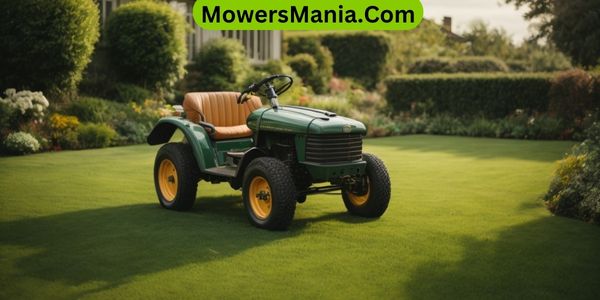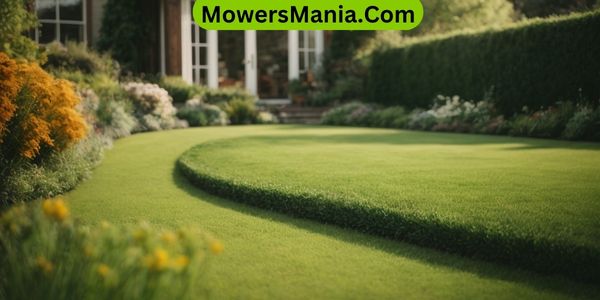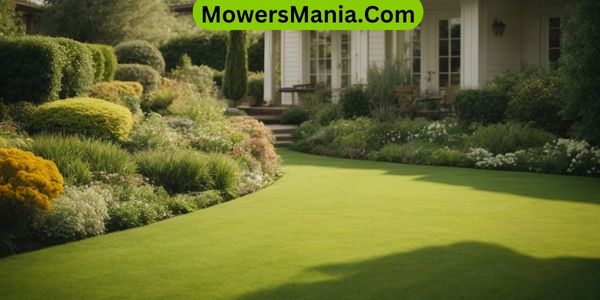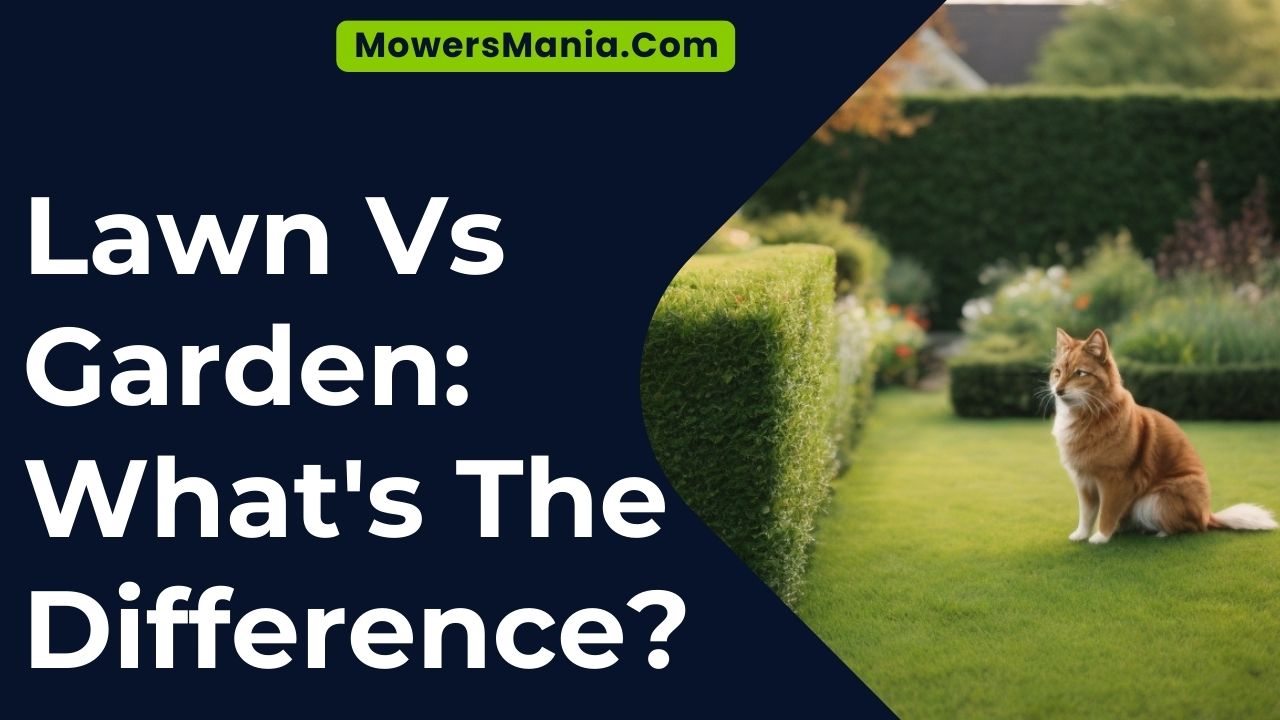Are you confused about the difference between a lawn and a garden? Don’t worry, we’ve got you covered. In this article, we’ll break it down for you and explain the distinctions between these two types of outdoor spaces.
From plant selection and maintenance to landscape design and environmental impact, we’ll explore all the factors that set lawns and gardens apart.

So, sit back, relax, and let us guide you through the world of lawns and gardens.
Definition and Purpose
To understand the difference between a lawn and a garden, you must first grasp the distinct definition and purpose of each.
A lawn typically refers to an area of land covered with neatly trimmed grass, often used for recreational activities or aesthetic purposes.
It’s meant to provide a clean and uniform appearance, creating a sense of order and symmetry in outdoor spaces.
The primary purpose of a lawn is to serve as a functional and visually pleasing backdrop for various activities, such as picnics, sports, or simply enjoying the outdoors.
On the other hand, a garden is more than just a patch of grass. It encompasses a variety of plants, flowers, shrubs, and even trees, carefully arranged and cultivated to create a visually appealing and diverse environment. The purpose of a garden goes beyond aesthetics.
It can serve as a sanctuary for wildlife, a source of fresh produce, or a place for relaxation and meditation.
Gardens are often designed with specific themes or purposes in mind, such as vegetable gardens, flower gardens, or herb gardens.
Plant Selection and Maintenance
Now let’s talk about choosing the right plants for your lawn or garden.
Choosing the Right Plants
When selecting and maintaining plants for your lawn or garden, it’s important to consider the specific needs and requirements of each plant. Different plants have different preferences for sunlight, water, soil conditions, and temperature.
Before choosing plants, assess the environmental conditions of your lawn or garden. Determine the amount of sunlight it receives throughout the day and the type of soil you have.
Some plants thrive in full sun, while others prefer partial shade. Similarly, some plants require well-draining soil, while others prefer moist or sandy soil.
It’s also crucial to consider the maintenance requirements of the plants. Some plants require regular pruning, fertilizing, or pest control, while others are low maintenance.
Proper Watering Techniques
Assess the specific water requirements of your chosen plants to ensure proper watering and maintenance.
Proper watering techniques are essential for the health and vitality of your garden. Here are three important tips to keep in mind:
Pest Control Methods
To effectively control pests in your garden, it’s important to select and maintain plants that are resistant to common pests. By choosing pest-resistant plants, you can reduce the risk of infestation and minimize the need for chemical pesticides.
Start by researching which plants are naturally resistant to the pests commonly found in your area. Native plants are often a good choice as they’ve evolved to withstand local pests.
Additionally, consider the health and vigor of the plants you select. Strong, healthy plants are more resistant to pests and diseases. Regularly inspect your plants for signs of pest damage and take immediate action if any issues arise.
Proper maintenance, such as regular watering and fertilizing, can also help strengthen plants and make them less susceptible to pests.
Landscape Design and Layout

To create an aesthetically pleasing outdoor space, start by considering the placement and arrangement of various elements within your landscape design.
Here are three important factors to keep in mind:
Functionality and Use
How can you maximize the functionality and use of your outdoor space?
One way is to carefully consider your needs and preferences when designing your lawn or garden. Think about how you plan to use the space and what activities you want to accommodate.
If you enjoy outdoor dining and entertaining, consider adding a patio or deck with seating areas and a barbecue grill. This will create a designated space for socializing and dining.
If you have children or pets, you may want to include a play area or a designated spot for them to run and play.
Additionally, think about incorporating functional elements such as pathways, lighting, and storage solutions to enhance the usability of your outdoor space.
Pathways can help define different areas and provide easy access to different parts of your lawn or garden. Adequate lighting will allow you to enjoy the space during the evenings and add a sense of security.
Storage solutions such as sheds or storage benches can help keep your outdoor tools and equipment organized and easily accessible.
Environmental Impact and Sustainability
Considering the environmental impact and sustainability of your outdoor space, you can further enhance its functionality and use.
Making mindful choices when it comes to your lawn or garden can’t only benefit the environment but also create a more sustainable and enjoyable outdoor space for you to enjoy.
Here are three ways you can minimize the environmental impact and promote sustainability:
- Reduce water usage: Lawns typically require a significant amount of water to stay green and lush. Consider replacing some or all of your lawn with native plants that are adapted to your region’s climate and require less water. Additionally, installing a drip irrigation system or using rain barrels to collect and reuse rainwater can help conserve water.
- Limit chemical use: Many traditional lawn care practices involve the use of chemicals such as fertilizers and pesticides, which can be harmful to the environment. Opt for organic or natural alternatives, or better yet, adopt organic gardening practices that focus on improving soil health and promoting natural pest control.
- Encourage biodiversity: Lawns often provide limited habitat for wildlife. By incorporating native plants, creating wildlife-friendly areas, and providing food and water sources, you can attract a variety of beneficial insects, birds, and other wildlife to your garden. This not only adds beauty and interest to your outdoor space but also helps support the local ecosystem.
Aesthetics and Visual Appeal

Enhancing the visual appeal of your outdoor space plays a crucial role in creating an inviting and enjoyable atmosphere. When it comes to choosing between a lawn and a garden, aesthetics should be a key consideration.
A well-maintained lawn can provide a neat and tidy appearance to your outdoor area. The lush green grass, neatly trimmed and evenly spread, creates a sense of tranquility and order.
The simplicity of a lawn can also make your space feel open and spacious, giving it a clean and polished look.
Additionally, a lawn can serve as a backdrop for other elements in your outdoor space, such as flower beds or seating areas, allowing them to stand out and add pops of color to the overall design.
On the other hand, a garden can bring a vibrant and dynamic element to your outdoor space. With a variety of plants, flowers, and shrubs, a garden can create a visually stunning and diverse landscape.
The different textures, colors, and heights of the plants can add depth and dimension to your space, making it more visually appealing.
A well-designed garden can also attract wildlife, such as butterflies and birds, adding a touch of nature to your surroundings.
Ultimately, the choice between a lawn and a garden depends on your personal preferences and the desired look and feel of your outdoor space.
Whether you opt for the simplicity of a lawn or the vibrancy of a garden, enhancing the visual appeal of your outdoor space will undoubtedly contribute to a more inviting and enjoyable environment.
Frequently Asked Questions [FAQs]
How Often Should I Mow My Lawn?
You should mow your lawn regularly to keep it looking neat and healthy. The frequency depends on factors like grass type and growth rate, but generally, once a week is a good starting point.
What Are Some Common Garden Pests and How Can I Control Them?
If you’re wondering about common garden pests and how to control them, there are a few options. You can use organic insecticides, create barriers, or attract beneficial insects to keep your garden protected.
Can I Grow Vegetables in My Lawn?
Yes, you can grow vegetables in your lawn. It’s a great way to utilize your space and enjoy homegrown produce. Just make sure to prepare the soil properly and provide enough sunlight and water for your vegetables to thrive.
Are There Any Specific Landscape Design Principles I Should Follow When Creating a Garden?
When creating a garden, there are specific landscape design principles you should follow. Consider factors like balance, focal points, and scale. Use elements like paths, borders, and plant groupings to create a visually appealing and functional outdoor space.
What Are Some Sustainable Practices I Can Implement in My Lawn or Garden?
To make your lawn or garden sustainable, you can implement practices like reducing water usage, using organic fertilizers, composting, practicing companion planting, and attracting beneficial insects.
Conclusion
In conclusion, understanding the difference between a lawn and a garden is crucial for creating an outdoor space that suits your needs and preferences.
While a lawn is typically a grassy area that requires regular mowing and minimal plant diversity, a garden allows for a wider range of plant selection, landscape design, and functional use.
Moreover, considering the environmental impact and aesthetics of your outdoor space will contribute to its sustainability and visual appeal.



